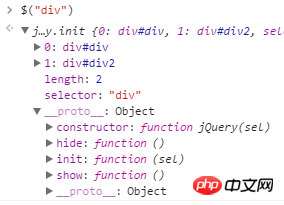Home > Article > Web Front-end > Detailed explanation of jQuery framework usage
This time I will bring you a detailed explanation of the use of the jQuery framework. What are the precautions when using the jQuery framework. The following is a practical case, let’s take a look.
The following will be introduced using simplified code, mainly focusing on the implementation ideas of jQuery~>_<~
//匿名立即执行函数
//.防止污染全局空间
//.选择性保护内部变量
(function(window, undefined){
//第二参数undefined设置而不传的原因:
// 外部发生这种情况:var undefined = 时,undefined会被篡改
// 设置第二参数而不传,则undefined就会被重置回原来值
function jQuery(sel){
return new jQuery.prototype.init(sel);
}
jQuery.prototype = {
constructor: jQuery,
init: function(sel){
if(typeof sel === 'string'){
var that = this;
//jQuery内部使用的是Sizzle,这里使用querySelectorAll替代
var nodeList = document.querySelectorAll(sel);
Array.prototype.forEach.call(nodeList, function(val, i){
that[i] = val;
})
this.selector = sel;
this.length = nodeList.length;
}
}
}
jQuery.prototype.init.prototype = jQuery.prototype;
//对外暴露jQuery:将jQuery绑定在window上面
window.$ = jQuery;
})(window);---------------- ----------
jQuery initially uses an anonymous immediate execution function to wrap it internally and expose it to the outside world on line 5;
The so-called anonymous immediate execution function is this The function is anonymous (no name) and is called immediately after being defined;
When we call $("p") externally, the internal jQuery("p") is actually called;
(function(window, undefined){
//内部变量
//对外暴露jQuery:将jQuery绑定在window上面
window.$ = jQuery;
})(window);
$("p")--------------------------
Okay, let’s get a little more complicated. The following code mainly implements As shown in the figure, mutual references:
Take the $('p') call as an example:

As can be seen from the 2nd line of code, jQuery uses jQuery.prototype.init to instantiate jQuery objects, but this will cause a problem:
Instantiation The object can only access variables under init, but not jQuery.prototype (the API provided by jQuery is bound to this object).
So, just write the 21st line of code and point init.prototype to jQuery.prototype.
This is done, use init to instantiate, and jQuery.prototype can be accessed under the init scope.
function jQuery(sel){
return new jQuery.prototype.init(sel);
}
jQuery.prototype = {
constructor: jQuery,
init: function(sel){
if(typeof sel === 'string'){
var that = this;
//jQuery内部使用的是Sizzle,这里使用querySelectorAll替代
var nodeList = document.querySelectorAll(sel);
Array.prototype.forEach.call(nodeList, function(val, i){
that[i] = val;
})
this.selector = sel;
this.length = nodeList.length;
}
}
}
jQuery.prototype.init.prototype = jQuery.prototype;Why use jQuery.prototype.init to instantiate objects instead of using jQuery functions directly?
Assuming that jQuery functions are used to instantiate objects, the references between objects can indeed be simplified to jQuery-->jQuery.prototype.
But the call will become cumbersome: new $('p'), so based on this consideration (guess (⊙0⊙)), a more complex implementation is used internally to simplify the call.
--------------------------
Okay, finally, let’s take a look at the implementation of init. The code is also simplified, and only the most commonly used situation is implemented.
jQuery will process the obtained nodeList into an array (to facilitate subsequent use), and mount some variables under it, such as length and selector.

init: function(sel){
if(typeof sel === 'string'){
var that = this;
//jQuery内部使用的是Sizzle,这里使用querySelectorAll替代
var nodeList = document.querySelectorAll(sel);
Array.prototype.forEach.call(nodeList, function(val, i){
that[i] = val;
})
this.selector = sel;
this.length = nodeList.length;
}
}
I believe you have mastered the method after reading the case in this article. For more exciting information, please pay attention to other related articles on the php Chinese website!
Recommended reading:
What are the commonly used techniques in JS
The above is the detailed content of Detailed explanation of jQuery framework usage. For more information, please follow other related articles on the PHP Chinese website!